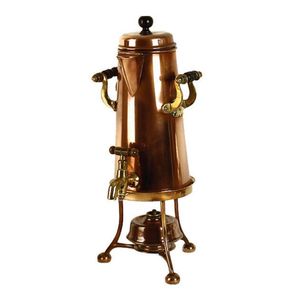George III Silver Hot Water Urn with Gryphon Crests
You must be a subscriber, and be logged in to view price and dealer details.
Subscribe Now to view actual auction price for this item
When you subscribe, you have the option of setting the currency in which to display prices to $Au, $US, $NZ or Stg.
- Circa - A Latin term meaning 'about', often used in the antique trade to give an approximate date for the piece, usually considered to be five years on either side of the circa year. Thus, circa 1900 means the piece was made about 1900, probably between 1895 and 1905. The expression is sometimes abbreviated to c.1900.
- George Iii - George III (1738 - 1820) was King of Great Britain and Ireland from 1760 to 1820.
- Griffin / Griffon / Gryphon - A griffin, also known as a griffon or gryphon, is a mythical creature with the body of a lion and the head of an eagle. It is typically depicted as a powerful and majestic beast, with the body and legs of a lion and the head, wings, and talons of an eagle. The griffin is widely recognized as a symbol of strength, courage, and guardianship, and has been used in a variety of cultures throughout history.
In ancient mythology, the griffin was often associated with the gods and was considered a symbol of divine power. In ancient Greece, for example, the griffin was associated with the sun god Helios, while in ancient Egypt, it was associated with the goddess Hathor. In medieval European heraldry, the griffin was used as a symbol of strength, valour, and protection, and was often featured on the coats of arms of noble families. - Verso - Verso is the "back" side of a sheet of paper, art work, coin or medal. The front side is "recto".
- Sterling Silver - Sterling silver is a mixture of 92.5% pure silver and 7.5% of another metal, usually copper. Fine silver is 99.9% pure silver, and is relatively soft and the addition of the very small amount of copper gives the metal enough strength and hardness to be worked into jewellery, decorative and household objects.
- Gryphon - A gryphon is a mythical beast with the head of an eagle and the body of a lion.
This fictional character was devised by Lewis Carroll in "Alice's Adventures in Wonderland", written in 1865. - Armorial / Armourial - Bearing a coat of arms. Coats of arms came into general use by feudal lords and knights in in the 12th century, and by the 13th century, arms had spread beyond their initial battlefield use to become a flag or emblem for families in the higher social classes of Europe. They were inherited from one generation to the next. When a family crest is used on individual items of silver or furniture it is an indicator of the aristocratic standing of the family represented.
Armorials were also used to decorate mass produced ceramic souvenir ware by such companies as Goss, Carlton & Shelley, and in these cases the coats of arms displayed were of boroughs and cities.
This item has been included into following indexes:
Visually similar items

A Victorian period copper tea urn, of conical shape with brass handles and tap, on original tripod base with spirits burner. Height 35 cm

A fine George III sterling silver hot water urn on stand with burner by John Wakelin & Robert Garrard I, London 1793, with detachable circular body engraved with a contemporary coat of arms and scallop shell spigot on four thread legs with lion paw feet an

A pair of impressive bronze and opaque panel hanging lanterns, French first half of the 20th century. Each approximately 180 cm high and 62 cm wide, together with an angular wall bracket which protrudes 62 cm with a branch of 58 cm. Provenance: The Hotel B

A fine George I walnut open armchair, early 18th century, with scroll top-rail and drop-in seat, on cabriole legs headed with protruding scrolls
